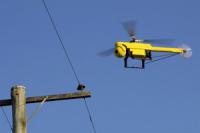-
Epigenetic technology to help in fight against WMD proliferation
Intelligence officers in the field, in trying to determine the presence or use of WMDs, would benefit from being able to check the epigenetic markers of an individual who may have come into contact with WMDs, read a history of any time he has been exposed to threat agents, and start piecing together a chain of evidence right there in the field, in real time. The epigenome is biology’s record keeper. Though DNA does not change over a single lifetime, a person’s environment may leave marks on the DNA that modify how that individual’s genes are expressed. DARPA’s new Epigenetic CHaracterization and Observation (ECHO) program aims to build a field-deployable platform technology that quickly reads someone’s epigenome.
-
-
Putting statistics into forensic firearms identification
When a gun is fired, and the bullet blasts down the barrel, it encounters ridges and grooves that cause it to spin, increasing the accuracy of the shot. Those ridges dig into the soft metal of the bullet, leaving striations. At the same time that the bullet explodes forward, the cartridge case explodes backward with equal force against the mechanism that absorbs the recoil, called the breech face. This stamps an impression of the breech face into the soft metal at the base of the cartridge case, which is then ejected from the gun. Researchers have developed a statistical approach for ballistic comparisons that may enable numerical testimony – similar to a DNA expert expressing the strength of the evidence numerically when testifying about genetic evidence.
-
-
Keeping the lights on if the world turns to 100% clean, renewable energy
Researchers propose three separate ways to avoid blackouts if the world transitions all its energy to electricity or direct heat and provides the energy with 100 percent wind, water, and sunlight. The solutions reduce energy requirements, health damage, and climate damage. “Based on these results, I can more confidently state that there is no technical or economic barrier to transitioning the entire world to 100 percent clean, renewable energy with a stable electric grid at low cost,” says one researcher.
-
-
Novel solution to better secure voice over internet communication
Researchers have developed a novel method to better protect Crypto Phones from eavesdropping and other forms of man-in-the-middle attacks. Crypto Phones consist of smartphone apps, mobile devices, personal computer or web-based Voice over Internet Protocol applications that use end-to-end encryption to ensure that only the user and the person they are communicating with can read what is sent. In order to secure what is being communicated, Crypto Phones require users to perform authentication tasks.
-
-
Improving military communications with digital phased-arrays at millimeter wave
There is increasing interest in making broader use of the millimeter wave frequency band for communications on small mobile platforms where narrow antenna beams from small radiating apertures provide enhanced communication security. Today’s millimeter wave systems, however, are not user friendly and are designed to be platform specific, lacking interoperability and are thus reserved for only the most complex platforms. New program aims to create multi-beam, digital phased-array technology, operating at 18-50 GHz to enhance secure communications between military platforms.
-
-
A custom-fit app for community policing
Apps allowing citizens to report crimes or incidents are now commonplace, but they generally fail to adapt local contexts, cultures and sensibilities. SecureU, a new app that addresses this shortcoming, is currently being tested in five European cities.
-
-
2017 Critical Incident Exercise put first responder technologies to the test
In the wee hours of 29 October 2017, more than 200 people participated in a critical incident exercise and technology assessment, conducted by DHS S&T and partner organizations. The exercise took place at the Grand Central Terminal in New York City, with most of the action occurring on parked trains and on track platforms, and other indoor spaces within the Terminal. Emergency medical technicians were dispatched to quickly convert ramps in front of several track platforms into triage stations. Outside, first responders set up an incident command post and an operations center to coordinate the simulated response.
-
-
Making network-connected systems less vulnerable
The rise of network-connected systems that are becoming embedded seemingly everywhere–from industrial control systems to aircraft avionics–is opening up a host of rich technical capabilities in deployed systems. Even so, as the collective technology project underlying this massive deployment of connectivity unfolds, more consumer, industrial, and military players are turning to inexpensive, commodity off-the-shelf (COTS) devices with general-purpose designs applicable for a range of functionalities and deployment options. While less costly and more flexible, commodity components are inherently less secure than the single-purpose, custom devices they are replacing. DARPA says it trains its sights on the expansive attack surface of commodity off-the-shelf devices.
-
-
$1 billion reward proposed for development of new antibiotics
An international group tasked with researching and developing new economic models to promote antibiotic development is calling for a $1 billion market entry reward for new antibiotics, saying the reward could significantly boost the number of new antibiotics coming to market over the next thirty years. The proposal was made by an international consortium of public health organizations, academic institutions, and pharmaceutical companies supported by the European Medicines Initiative. The $1 billion market entry reward is one of four incentives proposed by the group to stimulate research and development (R&D) for new antibiotics and ensure that critically needed antibiotics are used sustainably and continue to be accessible. “Without incentives, some scientifically promising treatments would probably never make it to patients,” says one expert.
-
-
Synthetic virus tackles antimicrobial resistance
Antibiotic resistance has become an ever-growing global challenge, with more than 700,000 people across the world dying from drug resistant infections every year. As a result, antibiotic discovery has fallen well behind its historical rate, with traditional discovery methods being exhausted. Scientists have engineered a brand new artificial virus that kills bacteria on first contact. This new virus is built using the same geometric principles that determine structures of naturally occurring viruses, known as polyhedral capsids.
-
-
Making production of high explosives cheaper, safer
Scientists from the U.S. Army Research Laboratory (ARL) and the Lawrence Livermore National Laboratory found a solution to a significant challenge in making high-energy explosives. They safely improved the overall chemical yield derived from diaminoglyoxime, known as DAG, and significantly increased the amount of material made per reaction.
-
-
Blast, impact simulations help researchers better understand injuries and body armor

Researchers at Sandia Lab have studied the mechanisms behind traumatic brain injury for about a decade. Their traumatic injury modeling and simulation project began with a head-and-neck representation, and now they’ve created a high-fidelity, digital model of a man from the waist up to study the minute mechanisms behind trauma. The specialized computer modeling and simulation methods help researchers better understand how blasts on a battlefield could lead to traumatic brain injury and injuries to vital organs, like the heart and lungs.
-
-
Drones learn to navigate autonomously by imitating cars, bicycles

Researchers have developed an algorithm called DroNet which allows drones to fly completely by themselves through the streets of a city and in indoor environments. The algorithm had to learn traffic rules and adapt training examples from cyclists and car drivers.
-
-
Using fungi for self-healing concrete to fix bridges
America’s crumbling infrastructure has been a topic of ongoing discussion in political debates and campaign rallies. The problem of aging bridges and increasingly dangerous roads is one that has been well documented and there seems to be a consensus from both democrats and republicans that something must be done. Researchers propose using fungi for self-healing concrete — a low-cost, pollution-free, and sustainable approach to shoring up U.S. infrastructure.
-
-
Thorium reactors could dispose of large amounts of weapons-grade plutonium
Scientists are developing a technology enabling the construction of high-temperature, gas-cool, low-power reactors with thorium fuel. The scientists propose to burn weapons-grade plutonium in these units, converting it into power and thermal energy. Thermal energy generated at thorium reactors may be used in hydrogen industrial production. The technology also makes it possible to desalinate water.
-
More headlines
The long view
New Technology is Keeping the Skies Safe
DHS S&T Baggage, Cargo, and People Screening (BCP) Program develops state-of-the-art screening solutions to help secure airspace, communities, and borders
Factories First: Winning the Drone War Before It Starts
Wars are won by factories before they are won on the battlefield,Martin C. Feldmann writes, noting that the United States lacks the manufacturing depth for the coming drone age. Rectifying this situation “will take far more than procurement tweaks,” Feldmann writes. “It demands a national-level, wartime-scale industrial mobilization.”
How Artificial General Intelligence Could Affect the Rise and Fall of Nations
Visions for potential AGI futures: A new report from RAND aims to stimulate thinking among policymakers about possible impacts of the development of artificial general intelligence (AGI) on geopolitics and the world order.
Keeping the Lights on with Nuclear Waste: Radiochemistry Transforms Nuclear Waste into Strategic Materials
How UNLV radiochemistry is pioneering the future of energy in the Southwest by salvaging strategic materials from nuclear dumps –and making it safe.
Model Predicts Long-Term Effects of Nuclear Waste on Underground Disposal Systems
The simulations matched results from an underground lab experiment in Switzerland, suggesting modeling could be used to validate the safety of nuclear disposal sites.
